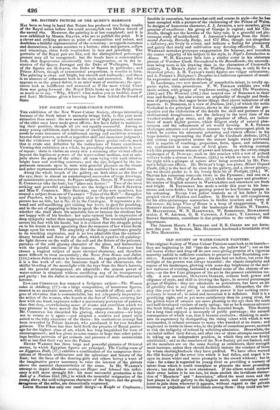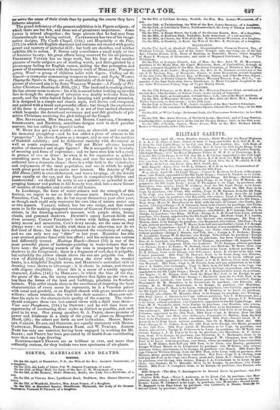OLD SOCIETY OF WATER-COLOUR PAINTERS.
THE original Society of Water-Colour Painters must look to its laurels— they are beginning to fall "into the sere, the yellow leaf"; nor as the old leaves wither and drop off do new ones giving promise of a vigorous maturity unfold in sufficient numbers to preserve their flourishing con- dition. BARRErr is the last gone : his sun had set before, but even the twilight of his powers was always beautiful : the classic simplicity and repose of his landscapes, glowing with noon-day brightness or the mel- low radiance of evening, indicated a refined sense of the charms of na- ture,—as the few faint glimpses of his art in the present exhibition tes- tify. A new associate, Ocrevios OAKLEY, evinces both power and elegance of style, and skill in drawing the figure, in several picturesque groups of Gipsies : they are admirable as portraiture, but have an air of gentility that is any thing but characteristic. Altogether, the dis- play this year is below par : in executive power it has nothing extra- ordinary to boast of; in mind and invention it is deficient Still it is a gratifying sight, and as yet more satisfactory than its young rival, for the golden hues of autumn are more pleasing to the eye than the scant and half-developed verdure of early spring; but as both seasons advance the fresh foliage will be preferred to the denuded bough. This Society for a long time enjoyed a monopoly of public patronage; the natural consequence of which was, that it became exclusive : thinking to main- tain its supremacy by disregarding the rising talent with which it was surrounded, it refused entrance to many who knocked at its doors ; and neglected to invite in those who, in the pride of conscious power, scorned to risk the indignity of refusal by soliciting admission. Meanwhile, the excluded rallied their forces, and after two or three attempts succeeded in taking up an independent position, in which they are now firmly established ; and as the numbers of the New Society are not limited, and all the members are on the same footing as exhibiters, their strength must increase, unless they should foolishly imitate the conduct of those by whose shortsightedness they have profited. We have often warned the Old Society of the error into which it had fallen, and urged it to open its doors wider and more promptly to the crowd without; but in vain : for a time it regarded its young rival as providing a nursery of talent from which it could transplant at pleasure the most promising shoots ; but that idea is now abandoned. If the elders would retrieve their error before it be too late, let them abolish the invidious distinc- tion of " Members " and "Associates," afford the most room and the best places in their gallery to the highest merit, and encourage excel- lence to join them wherever it appears, without regard to the private interests or prejudices of individuals among them : they could not bet- ter serve the cause of their rivals than by pursuing the course they have hitherto adopted.
The grand deficiency of the present exhibition is in Figure subjects; of which there are but few, and those not of prominent importance. Joint LEWIS is missed altogether ; the large picture that he had sent from Constantinople not having arrived. Caa-rmudoLE has two of his imagi- native designs' The Castle Chapel, (130,) and Hospitality to the Poor, (175,) in which old English character and costume are treated with poetic power and mastery of pictorial skill ; but both are sketches, and neither exhibits life in action. F. STONE only contributes a small study or two of feminine beauty; his great efforts being reserved for his oil-pictures. FREDERICK TAYLER has no large work, but his four or five smaller pictures of rustic subjects are of sterling worth, and distinguished by a picturesque feeling for English nature, uniting the fine perception and power of GAINSBOROUGH with the homely truth of MORIAND Trampere getting Wood—a group of children laden with fagots ; Calling out the Guard—a trumpeter summoning troopers to horse ; and Sophy Western Playing the Squire to Sleep, are each admirable of their kind. The only picture of elevated aim is by JOHN WILLIam Witimer—A Family of Pri- mitive Christians Reading the Bible, (28.) The husband is reading aloud; his lips almost seem to move : his wife is seated below looking up into his face as though the message of salvation was doubly welcome from his mouth, and the white-haired father is listening with profound attention. It is designed in a simple and classic style, well drawn and Composed, and painted with a broad and powerful effect ; but though the expression of the faces is eloquent of meaning, it is not of that exalted character which bespeaks the devotional reverence and soul-felt gratitude of pri- mitive Christians receiving the glad tidings of the Gospel.
Mrs. SEYFFARTH, Miss SHARPE, and Messrs. CRISTALL, CHISHOLM, STEPHANOPP, and RICHTER, contribute designs each in their peculiar manner, but not calling for especial notice. W. HUNT has got a new model—a man, as clownish and coarse as his immortal ploughboy—and he has added a piece of armour to his "properties" : his clown figures as a trooper, and as one of the carriers of Gadshill celebrity ; and he delineates rusticity with devotional as well as comic expression. Why will not HUNT advance beyond studies of character and single figures ? He is unequalled in intensity of meaning and force of expression ; and we have seen him tell a story in groups of two or three : he owes it to his reputation to achieve something more than he has yet done, and cast the materials he has collected into a dramatic shape : there is a wide field in the vicissitudes and enjoyments of the rural population, and one in which he might work great good as well as excite new interest. His Interior of West Hill House (299) is over-elaborated, and wants keeping; all the details press equally on the eye, and the figure is comparatively lifeless and insubstantial : we should be sorry to see a painter, so powerful in ex- presping humour and pathos in his homely way, sink into a mere limner of outsides of clodpoles and insides of old houses.
In Landscape, the forte of water-colours and the strength of this Society, we regret to see so little advance made. DEWINT, COPLEY FIELDING, Cox, VARLET, &C. do but repeat themselves year after year, as though each could only represent his own idea of nature under one or two aspects. VARLEY, indeed, has but one recipe, and that would seem to be for making elongated versions of GASPAR Poussrres compo- sitions, in the drawing-master's manner, with purple skies, brassy clouds, and gummed shadows. Dawntr's sunny harvest-fields and river scenery, COPLEY FIELDING'S downs with falling showers, and misty moors and mountains, Cox's dewy meads, are the same as they always were : we would hardly wish them to be otherwise, nor do we feel tired of them ; but they have exhausted the vocabulary of eulogy, and we can only now say " ditto " to last year. HARDING has this year attained greater force with less effort ; and his subjects are various and differently treated. Hastings Beach—Sunset (70) is one of the most powerful pieces of landscape-painting in water-colours that we have seen ; the glowing warmth of the tone is tempered by the cool shadows in the foreground; there is a fragment of rock that is palpable, but unluckily the yellow clouds above the sun are palpable too. His view of Endskigh, (144,) looking along the river with its wooded banks, is a delightful English scene, and HARDING'S unrivalled skill in drawing trees shows to advantage : it is chaste in colour, and treated with elegant simplicity. Above this is a scene of a totally opposite character, Lisbon, (1430 by HOLLAND; in which the blue of the sky, the green of the sea, the sunny atmosphere that lights up the view, no less than the forms of the land and buildings, proclaim its Southern latitude. This artist stands alone in the excellence of depicting the local characteristics of every scene be represents, be it a Venetian palace with canal and gondola, or an English church with green meadows and willows: others translate the view into their manner ; HOLLAND sub- dues his style to the characteristic quality of the country. The visiter should compare these two last-named views with a third near them— View near Pangbourn, (134,) by Dawrarr ; and he will then have an opportunity of contrasting three styles as distinct as possible, and each good in its way. One young member, Cr. A. FRIPP, shows promise of power and freshness in a study of the group of pines on Hampstead Heath, (29) ; the others put forth no new indications. Messrs. BENT- LEY, CALLOW, EVANS, and GLENNIE, are equally stationary with Messrs. GASTINEAU, NESFIELD, FREDERICK NASH, and W. TURNER. JOSEPH Rasa has only one exterior, having been engaged in working for Mr. BARRY' and PROUT has been prevented by ill health from contributingthanmore than one large drawing.
BARTHOLOMEW'S Flowers are as brilliant as ever, and more than ordinarily curious, for they include two rare specimens of air-plants.



























 Previous page
Previous page